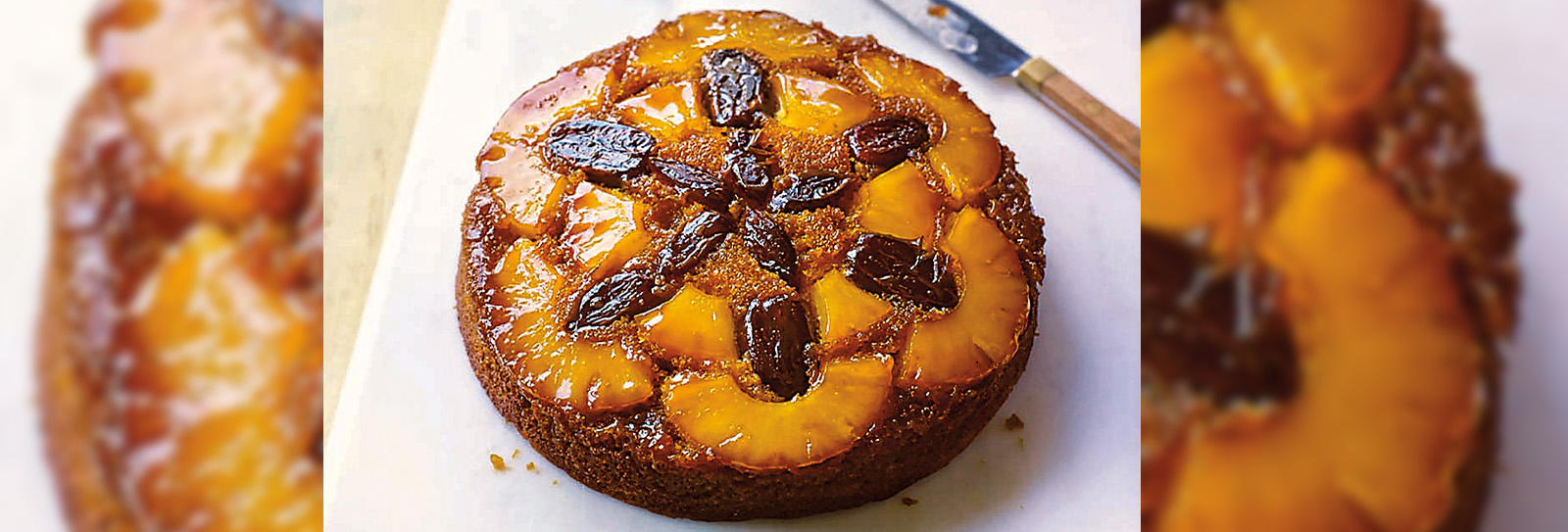
Adapted From Babylon: Easy Pineapple Upside Down Cake
Palace cake was made in honor of the gods who were worshipped in the temples of Ur on the banks of the Euphrates. It contained raisins, aniseed, and an unbelievable amount of fat and dates.
Not long ago, writing tablets from 1700 BCE were discovered in present-day Iraq, containing some of the oldest recipes known.
This is how we came to know what the Babylonians ate for breakfast and what they offered their gods in the temples. They used date syrup to sweeten food, referring to it as honey, and enjoyed dates dried in a fermented beverage. Palace cake was made in honor of the gods who were worshipped in the temples of Ur on the banks of the Euphrates. It contained raisins, aniseed, and an unbelievable amount of fat and dates. The original recipe mentions “oodles of butter” and vine leaves to line the baking dish—Babylonian wax/greaseproof paper, of sorts. This lightened version, with pineapple and date slices arranged in a sunny pattern, is delicious and far more digestible.
Preheat the oven to 190 degrees Celsius (375 degrees Fahrenheit/gas 5). Grease a 20-centimeter (eight-inch) tarte tatin pan or round cake pan.
To make the caramel topping (which will be baked as the base), put the butter and brown sugar in a saucepan over medium heat. Stir continuously until the sugar has dissolved and started to bubble at the sides. Pour the syrup into the pan and swirl to coat the base. Arrange the dates in a circular pattern, cut-side up. Do the same with the pineapple, placing chunks between each date.
Beat the butter and sugar together in a large bowl until light and creamy. Gradually add the eggs and vanilla, fold in the flour and baking powder, and mix well to combine. Spoon the mixture into the pan over the fruit, smoothing with the back of a spoon to ensure all the fruit is covered.
Bake for 25–30 minutes until risen, golden and a skewer inserted into the center of the cake comes out clean. Leave to cool in the pan for 5 minutes before inverting onto a serving plate and glazing the top with honey. Serve warm.
Adapted and reprinted with permission from Sun Bread and Sticky Toffee: Date Desserts From Everywhere
Sarah al-Hamad.
Interlink Books, 2013.
interlinkbooks.com.

You may also be interested in...

Warm Up Your Table With Sally Butchers Afghan Split Pea Soup (Dal Nokhod)
Food
This is one of those sneaky, apparently super simple dishes that actually has a ton of stuff in it.
Recipe: Chickpeas for Breakfast: Try Punjabi Chole Masala Recipe
Food
Chole masala is a popular breakfast dish of chickpeas.
Muhalbiyat Al-Sagoo: A Fresh Spin on Sago and Lychee Pudding
Food
Obtained from the trunks of various palms, sago is used across Asia as a thickener for soups and stews and to make pudding. You can substitute other soft, sweet fruit like plums or pineapple, but the sweet juice of the lychee blends very well with milk. This is an exotic take on the traditional sago pudding popular in Gulf cuisine, made with sago, sugar and spices.